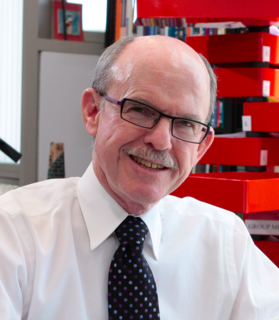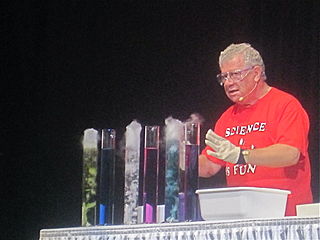Related Research Articles

The American Chemical Society (ACS) is a scientific society based in the United States that supports scientific inquiry in the field of chemistry. Founded in 1876 at New York University, the ACS currently has more than 155,000 members at all degree levels and in all fields of chemistry, chemical engineering, and related fields. It is one of the world's largest scientific societies by membership. The ACS is a 501(c)(3) non-profit organization and holds a congressional charter under Title 36 of the United States Code. Its headquarters are located in Washington, D.C., and it has a large concentration of staff in Columbus, Ohio.
William von Eggers Doering was the Mallinckrodt Professor of Chemistry at Harvard University. Before Harvard, he taught at Columbia (1942–1952) and Yale (1952–1968).

Kendall Newcomb Houk is a Distinguished Research Professor in Organic Chemistry at the University of California, Los Angeles. His research group studies organic, organometallic, and biological reactions using the tools of computational chemistry. This work involves quantum mechanical calculations, often with density functional theory, and molecular dynamics, either quantum dynamics for small systems or force fields such as AMBER, for solution and protein simulations.

Richard Neil Zare is the Marguerite Blake Wilbur Professor in Natural Science and a Professor of Chemistry at Stanford University. Throughout his career, Zare has made a considerable impact in physical chemistry and analytical chemistry, particularly through the development of laser-induced fluorescence (LIF) and the study of chemical reactions at the molecular and nanoscale level. LIF is an extremely sensitive technique with applications ranging from analytical chemistry and molecular biology to astrophysics. One of its applications was the sequencing of the human genome.

William Platt Jencks was an American biochemist. He was noted particularly for his work on enzymes, using concepts drawn from organic chemistry to understand their mechanisms.
Peter John Stang is a German American chemist and Distinguished Professor of chemistry at the University of Utah. He was the editor-in-chief of the Journal of the American Chemical Society from 2002 to 2020.

Bassam Z. Shakhashiri is a professor of Chemistry at the University of Wisconsin-Madison, where he is the holder of the William T. Evjue Distinguished Chair. An active advocate for science education, he is the author of multiple books of chemical demonstrations. He was the 2012 president of the American Chemical Society and has received numerous awards and honors.

Howard E. Zimmerman was a professor of chemistry at the University of Wisconsin–Madison. He was elected to the National Academy of Sciences in 1980 and the recipient of the 1986 American Institute of Chemists Chemical Pioneer Award.

Emma Perry Carr was an American spectroscopist and chemical educator.
Andrew Streitwieser is an American chemist known for his contributions to physical organic chemistry.
Hubert Newcombe Alyea was an American professor of chemistry at Princeton University. His explosive chemistry demonstrations earned him the nickname "Dr. Boom." He was famous around the world for his "zany, eccentric" public lectures on science, which "were as much performance as professorship." Alyea served as inspiration for the title character in the 1961 film The Absent-Minded Professor.
Gerhard Ludwig Closs was an American chemist specializing in physical organic chemistry, member of the National Academy of Sciences and the American Academy of Arts and Sciences, chairman of the chemistry department at the University of Chicago. Closs made seminal contributions in research of the magnetic properties of the intermediate compounds formed in chemical reactions. He is also credited with the discovery that certain reactions polarize atomic nuclei. The National Academies Press called him "one of the outstanding chemists of the post-World War II era". He was also an early leader in the field of carbene chemistry. The New York Times called him "pioneering chemist".
Joseph B. Lambert is an educator, organic chemist, archaeological chemist, and nuclear magnetic resonance spectroscopist. He grew up in the San Antonio, Texas, area and graduated from Alamo Heights High School in 1958. He was educated at Yale University, where he worked for William von Eggers Doering, and at California Institute of Technology (1965), where he worked for John D. Roberts. In 1965, he joined the faculty of Northwestern University in Evanston, Illinois, where he rose through the ranks and in 1991 became Clare Hamilton Hall Professor of Chemistry. In 2010, he retired after 45 years at Northwestern and moved to Trinity University in San Antonio to assume his current position as Research Professor of Chemistry.

Mary Lura Sherrill was recognized for her achievements in chemical research, particularly the synthesis of antimalarial compounds, and for her teaching at Mount Holyoke College. In 1947, she received the Garvan Medal, an award for women in chemistry.
James Flack Norris was an American chemist. Born in Baltimore, Maryland to a Methodist minister, Norris was educated in Baltimore and Washington, D.C. before studying at Johns Hopkins University, where he graduated with an A.B. in Chemistry. After graduating in 1892, he remained at the university to work as a Fellow until 1895, when he was awarded his Ph.D. and became an academic at the Massachusetts Institute of Technology (MIT). He left MIT in 1904 to become the first Professor of Chemistry at the newly formed Simmons College, before returning to take up the position of Professor of Organic Chemistry and, after its creation in 1926, the first Director of MIT's Research Laboratory of Organic Chemistry.

Henry Aaron Hill was an American chemist who became the first African American president of the American Chemical Society (ACS). As a scientist, he specialized in the chemistry of fluorocarbons.

Zafra M. Lerman is an American chemist, educator, and humanitarian. She is the President of the Malta Conferences Foundation, which aims to promote peace by bringing together scientists from otherwise hostile countries to discuss science and foster international scientific and technical collaboration. From 1986 to 2010, she chaired the American Chemical Society's Subcommittee on Scientific Freedom and Human Rights. She has been successful in preventing executions, releasing prisoners of conscience from jail and bringing dissidents to freedom. She is the recipient of many awards for education and science diplomacy, including the 1999 Presidential Award from U.S. President Clinton, the 2005 Nyholm Prize for Education from the Royal Society of Chemistry (England), the 2015 Science Diplomacy Award from the American Association for the Advancement of Science (AAAS), the 2016 Andrei Sakharov Award for human rights from the American Physical Society (APS), and the 2016 United Nations NOVUS Award for the 16th Sustainable Development Goal: Peace and Justice.

Neil K. Garg is currently a Distinguished professor of chemistry and holds the Kenneth N. Trueblood Endowed Chair at the University of California, Los Angeles. Garg's research is focused on the chemical synthesis of organic compounds, with an emphasis on the development of new strategies for the preparation of complex molecules possessing unique structural, biological, and physical properties. His group has made breakthroughs in catalysis and in the understanding and utilization of strained intermediates, such as arynes, cyclic alkynes, and cyclic allenes. His laboratory has completed the total syntheses of many natural products, including welwitindolinones, akuammilines, and tubingensin alkaloids.
Angelica M. Stacy is the Associate Vice Provost for the Faculty and Professor of Chemistry at the University of California, Berkeley. Stacy was one of the first women to receive tenure in the College of Chemistry at UC Berkeley.
References
- ↑ "The Northeastern Section of the American Chemical Society". NESACS. Retrieved 2010-04-13.
- ↑ "Archived copy" (PDF). Archived from the original (PDF) on 2007-03-07. Retrieved 2010-04-13.
{{cite web}}: CS1 maint: archived copy as title (link) - ↑ Biographical memoirs - Google Livres. 15 January 1974. ISBN 9780309022392 . Retrieved 2010-04-13.